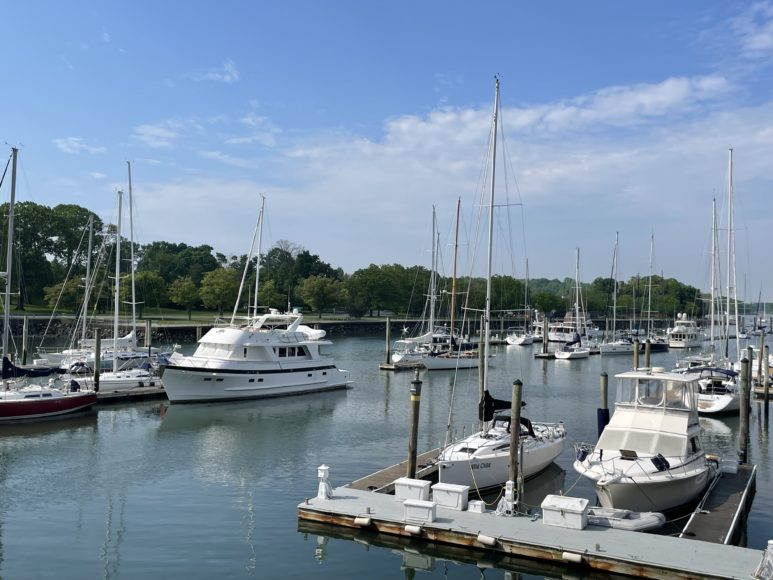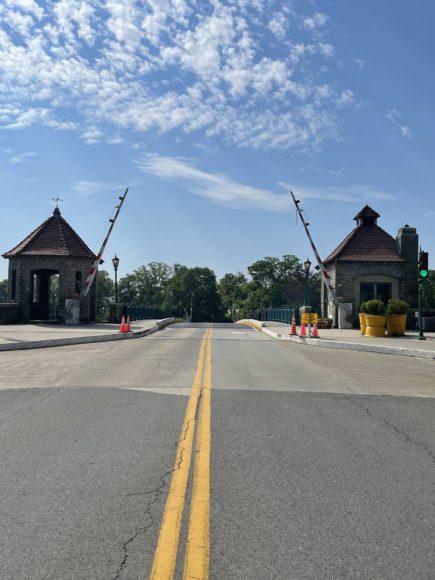In 1878, U.S. Congressman John H. Starin bought Glen Island for his summer estate, along with four small islands nearby to create a summer resort for city dwellers. Connected by a series of piers and causeways, each island would feature a different international theme, so that while there were no rollercoasters or haunted houses, Glen Island was effectively one of America’s first “themed” parks.
Its popularity was immense. At the height of the summer season, no fewer than 12 steamboats headed up from New York City to New Rochelle daily to enjoy attractions that included a zoo; a small, natural history museum; a miniature steam railway; a pagoda; and — around the castle-like structures still standing today — a German beer garden. A chain ferry, whereby passengers were pulled across a fixed line, transported visitors from the mainland dock on Neptune Island to the other islands. A bathing beach was also available for those who wanted to enjoy a gentle paddle or dip in the Long Island Sound, although the concept of “sunbathing” as we know it was still some decades off.
Starin’s aim was to offer an environment of order and civility that contrasted with the rough-and-tumble atmosphere of New York City, and in that he certainly succeeded. Additionally, as a direct consequence of the success and popularity of the park, New Rochelle, a onetime French-Huguenot haven that had already been established as a summer resort, began to enjoy wider popularity and develop as a year-round community, quickly becoming known as “the jewel of Westchester County,” which acquired the site in 1923 and has managed it as a public park ever since.
Another of Glen Island’s attractions — indeed for many, its main attraction, dating from its inception — was the Glen Island Casino. With a magnificent location at the water’s edge, this pleasure palace, complete with ballroom, banqueting suites and supper club, enjoyed its heyday in the 1930s — despite Prohibition, or perhaps because of it, since the casino was known as something of a speakeasy. It was certainly a springboard to success during the Big Band era, for the likes of Ozzie Nelson, Charlie Barnet, Claude Thornhill, Les Brown, Tommy and Jimmy Dorsey and Glenn Miller, as well as many others. (A full recording of “The Glenn Miller Orchestra: Live at Glen Island Casino 1939,” which includes “Moonlight Serenade” and “Beer Barrel Polka,” is available online.)
After a recent $10 million-dollar renovation, the casino, still county owned and operated but now known as the Glen Island Harbour Club, is a hugely sought-after venue, especially for weddings, billing itself as “Westchester’s premier banquet facility.” Executive chef Albert Duga is a graduate of the Culinary Institute of America, and was previously at the Waldorf Astoria New York, with prior stints at the Palace Restaurant and Le Cirque, both also in the Manhattan.
The 105-acre park closed to the public at the start of Covid in March 2020, to be used as a Covid-testing station but reopened in time for the summer season in 2021. As County Executive George Latimer put it at the time of reopening: “It was here in New Rochelle that the first case of Covid-19 in Westchester was detected. At the time, the drive-through testing was what we needed, but now what we need is for our residents to have their park back.” Happily, they do.
Speaking with WAG recently, Peter Tartaglia, first deputy commissioner of the county’s Parks, Recreation and Conservation Department, described the situation similarly. “When New Rochelle was like ground zero, with so many unknowns…we were disappointed that we couldn’t service the public (as a park). But we were happy that we were able to help understand and beat down this horrible pandemic we’re all going through.”
Although county residency is required for parking and beach access, the park is still open to all. Around 150,000 visitors annually enjoy park experiences largely unchanged in 130 years, including the lush park grounds, the castles (looking much the same as they did in Starin’s original resort) and breathtaking sunsets. Only the dramatic views of the New York skyline and bridges have changed. The park is also a wonderful place for people to picnic.
While the number of visitors may seem high, it is small compared to when the park first opened. By 1882, four years after opening, half a million visitors had already passed through the turnstiles. Six years after that, the gate exceeded a million. However, despite the large number of visitors, Starin stressed the “well-behaved” nature of the crowds and the orderly character of the experience, governed by what he called a “middle-class code of conduct.” While Tartaglia commented with a laugh that he “wouldn’t phrase it in quite those same terms” today, good conduct is generally a hallmark of the park, he says.
“People are generally well-behaved, we have seasonal police and we also have patrols by county police. And we have good staff,” he told WAG. “ Now do you have a little skirmish because of the amount of people from time to time? Absolutely. It happens everywhere. But, generally, we find that most people take ownership of the park. To have this undeveloped property right on Long Island Sound is just amazing.” He said there’s a sense of pride that comes from the park staff, too. Maintenance and planting are overseen by a team of four senior gardeners, with a large number of daily and hourly seasonal gardening and administrative staffers who are hired as necessary.
“It comes from our workers and the public, (which) sort of feeds into each other. And by the way,” he added, with a palpable display of civic pride, “that’s the way we run our department also.”
Looking to the future, the county is considering applying to have the sea wall and bridge leading to the park listed on the National Register of Historic Places. It is also planning a complete rehab of the bridge — which is a drawbridge and the only way of accessing Glen Island — within the next few years. Tartaglia explained the twofold benefit of being on the register and why he hopes the application will be successful. “It’s a wonderful thing to preserve history but (being on the register) also helps to get grant funding. It also shows there are a lot of interested groups that will work with us, including the federal and state governments.”
The bridge itself, he pointed out, is historic and its architecture will be saved. “We have to do some modern fixes, because we’re looking at extending its lifespan by 50 years while preserving its historical character. But don’t forget, just as there’s always been, there’s only one way in and one way out of Glen Island Park, unless you have a boat.”
For more, visit parks.wetchestergov.com.



